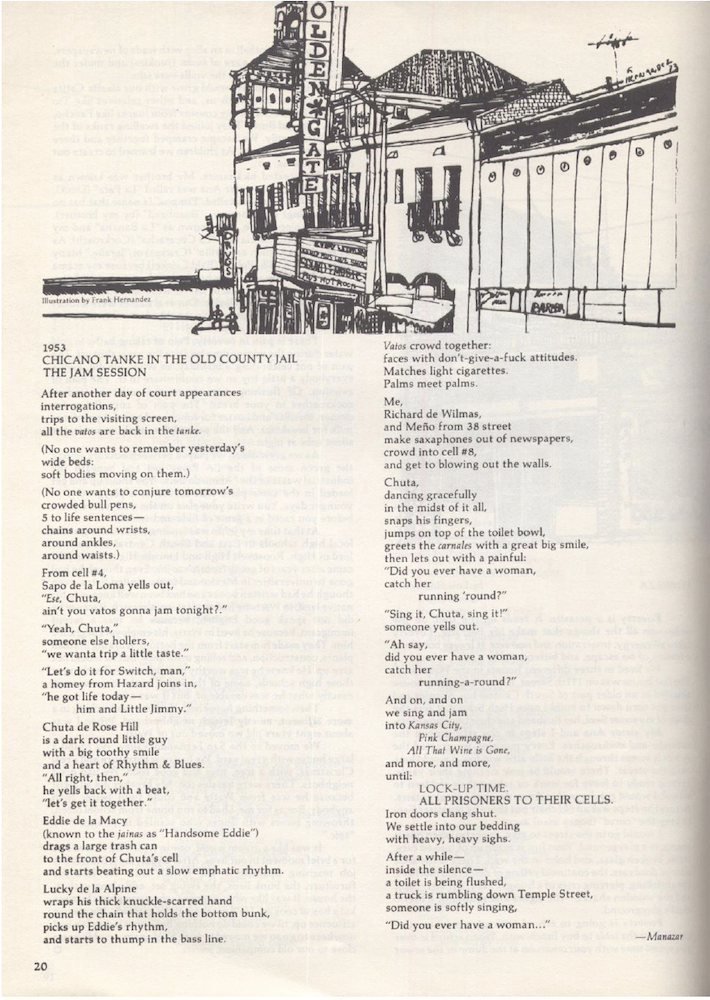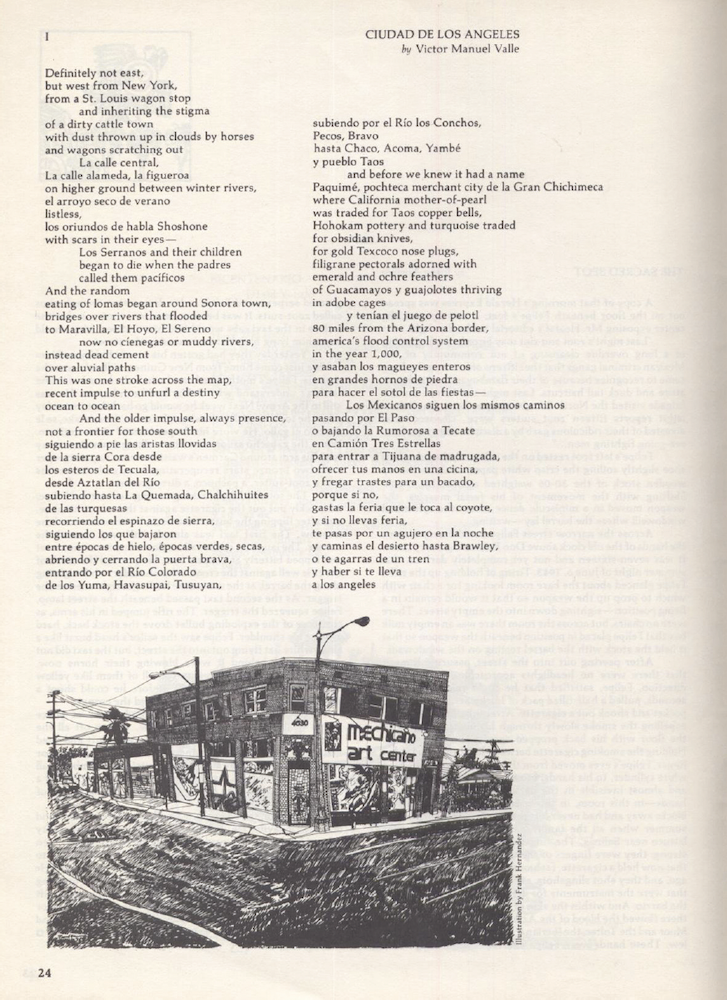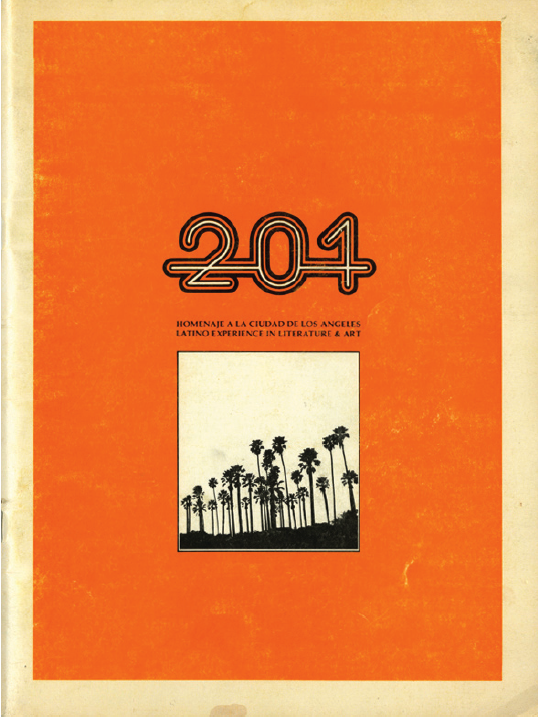The slider below contains 3 slides.
1953 Chicano Tanke in the Old County Jail “The Jam Session”
By Manazar
Credit: ChismeArte Magazine No. 8
After another day of court appearances
interrogations,
trips to the visiting screen,
all the vatos are back in the tanke.
(No one wants to remember yesterday’s
wide beds:
soft bodies moving on them.)
No one wants to conjure tomorrow’s
crowded bull pens,
5 to life sentences—
chains around wrists,
around ankles,
around waists.)
From cell #4,
Sapo de la Loma yells out,
“Ese, Chuta,
ain’t you vatos gonna jam tonight?”
“Yeah, Chuta,”
someone else hollers,
“we wanta trip a little taste.”
“Let’s do it for Switch, man,”
a homey from Hazard joins in,
“he got life today—
him and Little Jimmy.”
Chuta de Rose Hill
is a dark round little guy
with a big toothy smile
and a heart of Rhythm & Blues.
“All right, then,”
he yells back with a beat,
“let’s get it together.”
Eddie de la Macy
(known to the jainas as “Handsome Eddie”)
drags a large trash can
to the front of Chuta’s cell
and starts beating out a slow emphatic rhythm.
Lucky de la Alpine
wraps his thick knuckle-scarred hand
round the chain that holds the bottom bunk,
picks up Eddie’s rhythm,
and starts to thump in the bass line.
Vatos crowd together:
faces with don’t-give-a-fuck attitudes.
Matches light cigarettes.
Palms meet palms.
Me,
Richard de Wilmas,
and Meño From 38 street
make saicaphones out of newspapers,
crowd into cell #8,
and get to blowing out the walls.
Chuta,
dancing gracefully
in the midst of it all,
snaps his fingers,
jumps on top of the toilet bowl,
greets the carnales with a great big smile,
then lets out with a painful:
“Did you ever have a woman,
catch her
running ’round?”
“Sing it, Chuta, sing it!”
someone yells out.
“Ah say,
did you ever have a woman,
catch her
running-a-round?”
And on, and on
we sing and jam
into Kansas City,
Pink Champagne,
All That Wine is Gone.
and more, and more,
until:
LOCK-UP TIME.
ALL PRISONERS TO THEIR CELLS.
Iron doors clang shut.
We settle into our bedding
with heavy, heavy sighs.
After a while—
inside the silence—
toilet is being flushed,
a truck is rumbling down Temple Street,
someone is softly singing,
“Did you ever have a woman … “
— Manazar
Ciudad de Los Angeles
By Victor Manuel Valle
Credit: ChismeArte Magazine No. 8
I
Definitely not east,
but west from New York,
from a St. Louis wagon stop
and inheriting the stigma
of a dirty cattle town
with dust thrown up in clouds by horses
and wagons scratching out
La calle central,
La calle alameda, la figueroa
on higher ground between winter rivers,
el arroyo seco de verano
listless,
los oriundos de habla Shoshone
with scars in their eyes—
Los Serranos and their children
began to die when the padres
called them pacíficos
And the random
eating of lomas began around Sonora town,
bridges over rivers that flooded
to Maravilla, El Hoyo, El Sereno
now no cíenegas or muddy rivers,
instead dead cement
over aluvial paths
This was one stroke across the map,
recent impulse to unfurl a destiny
ocean to ocean
And the older impulse, always presence,
not a frontier for those south
siguiendo a pie las aristas llovidas
de la sierra Cora desde
los esteros de Tecuala,
desde Aztatlan del Río
subiendo hasta la Quemada, Chalchihuites
de las turquesas
recorriendo el espinazo de sierra,
siguiendo los que bajaron
entre épocas de hielo, épocas verdes, secas,
abriendo y cerrando la puerta brava,
entrando por el Río Colorado
de los Yuma, Havasupai, Tusuyan,
subiendo por el Río los Conchos,
Pecos, Bravo
hasta Chaco, Acoma, Yambé
y pueblo Taos
and before we knew it had a name
Paquimé, pochteca merchant city de la Gran Chichimeca
where California mother-of-pearl
was traded for Taos copper bells.
Hohokam pottery and turquoise traded
for obsidian knives,
for gold Texcoco nose plugs,
filigrane pectorals adorned with
emerald and ochre feathers
of Guacamayos y guajolotes thriving
in adobe cages
y tenían el juego de pelotl
80 miles from the Arizona border,
america’s flood control system
in the year 1,000,
y asaban los magueyes enteros
en grandes hornos de piedra
para hacer el sotol de las fiestas—
Los Mexicanos siguen los mismos caminos
pasando por El Paso
o bajando la Rumorosa a Tecate
en Camión Tres Estrellas
para entrar a Tijuana de madrugada,
ofrecer tus manos en una cicina,
y fregar trastes para un bacado,
porque si no,
gastas la feria que le toca al coyote,
y si no llevas feria,
le pasas por un agujero en la noche
y caminas el desierto hasta Brawley,
o te agarras de un tren
y haber si te lleva
a los angeles
victor Valle
By Brett McClain & Matthew Gilbert
From the 2008 Exhibit
His earliest biographer described the Southern California native as a poetry, award-winning translator, and literary editor with one foot in his neighborhood, and the other in Latin American literature. Emphasizing his poetry, Enrique La Madrid wrote: “Valle’s poems explore the links and contradictions between the deeply personal and the historical, opposite poles of experience that are usually alienated or dichotomized in most American poetry. In Valle’s poetry they reach a powerful synthesis.” The biographer’s description proved accurate in most respects. But the 1982 entry, published after Valle had edited and contributed to ChismeArte for seven years, and after starting his The Los Angeles Times reporting career, did not predict his Cultural Studies scholarship or book-length works of literary non-fiction.
The possibilities of non-fiction narrative no doubt opened up to him at the Los Angeles Times, an eight-year period in which time he won honors for investigative journalism and a Pulitzer Prize in 1984 as a member of the reporting team that wrote a multi-article series on Southern California’s Latino community. The New Press published his first book-length experiment with the form, Recipe of Memory: Five Generations of Mexican Cuisine, in 1995. The hybrid memoir/culinary history garnered three literary nominations from two leading book competitions, a translation into Italian, and inclusion into the Library of America’s 2007 edition of …. Since then, the University of Minnesota Press has published (2000) Latino Metropolis, his book-length study of the political, economic, and cultural ramifications of a L.A.’s Latino plurality. His next book, City of Industry: A Genealogy of Power, is forthcoming from the University of Minnesota Press.




